It hasn’t been long since I departed El Chaltén, but sitting in quarantine due to the Covid-19 pandemic, it already feels like a long time ago. I spent the entirety of January and February in El Chaltén (Argentine Patagonia), teamed up for the month of January with Fabian Buhl, and teamed up for the month of February with Alex Honnold.
JANUARY – CLIMBING WITH FABI
Fabi and I were quite unlucky with the weather during our period of climbing together. We arrived in El Chaltén the evening of January 1st, exactly at the end of a 3-day good weather window. The rest of January was exceptionally bad weather, so our climbing activity was pretty limited. Our main agenda while teamed up together was to try a new route on the far left side of Cerro Torre’s south face, which would lead into the upper portion of the Ragni Route. In the first half of January we had only two extremely brief weather windows (well less than 24 hours of good weather). We knew that these weather windows were far too small to climb the south face of Cerro Torre, but we headed to our intended line nonetheless, to learn the approach and the lower portion of the route. The result is that we “wasted” two very small weather windows, but I still think it was a good choice over all. The weather windows that we “wasted” were big enough to climb something like El Mocho or Medialuna, but both of us felt far more inspired to go explore and fail on the south face of Cerro Torre than to succeed on these little rock climbs.
At the base of Cerro Torre’s south face is a small hanging glacier, nestled into a concavity at the base of the wall. It is clearly the easiest, fastest route onto the wall proper, but is extremely exposed to any debris falling off the wall above. Thus, on our first foray (on Jan. 9), we opted to climb some mixed terrain off to the left of the hanging glacier – a more difficult and time-consuming option, but a safer choice. This mixed terrain proved more difficult than it looked, particularly because the rock was poor and it was covered in powder snow, and by afternoon we arrived only to the top, left edge of the hanging glacier. When we arrived at the top of the glacier it also started to snow very heavily, and soon we were rappelling down through the spindrift. Over the course of the day we never saw anything big and scary fall onto the hanging glacier, and thus decided that for our second foray we would climb up the hanging glacier instead.














On our second foray (Jan. 18) it was much warmer, and ice and water were falling down Cerro Torre’s south face. The hanging glacier was pretty easy to ascend, but it was somewhat stressful, as many bits of ice bombarded us from high above. At the top of the hanging glacier there is a line of ice that forms sometimes, but it was clearly running with water and falling apart. Instead, I switched into rock shoes and headed up an arête to the left that was the other most logical option. Within meters of the belay, I started throwing many small, loose rocks off the pitch, and gingerly avoiding the larger ones. Good protection was difficult to find. Slowly, and extremely carefully, I climbed up about 15 or 20 meters before abandoning the idea – the rock quality was just too bad. Although I pretty much always prefer solid rock, I can certainly appreciate the additional complexity and concentration that climbing on poor rock requires. However, at some point it simply feels too dangerous – that the chance of climber or belayer getting hit by a big block is simply too high. It felt to me that it was at that level of rock quality, so when I was able to find a solid piton placement I lowered off.




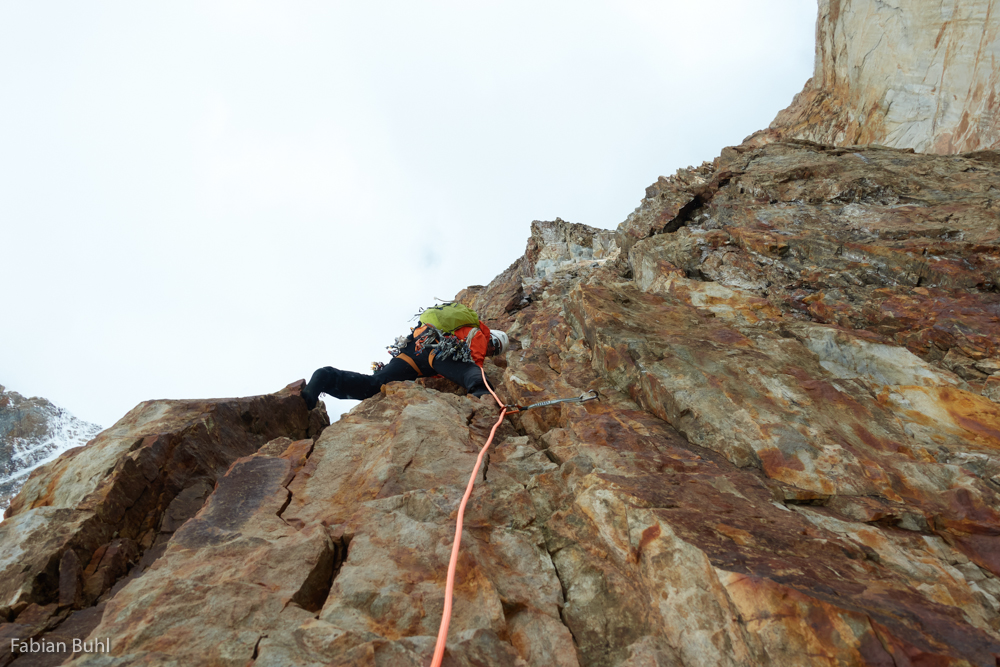

There was another brief spell of decent weather on the very last day of January. Fabi and I made a car-to-car traverse of Cerro Electrico and Aguja Guillaumet, climbing the easiest route on each. It was a day with very easy climbing, but involved moving fast and covering a lot of terrain, which was a nice contrast to our two forays on Cerro Torre.




FEBRUARY – CLIMBING WITH ALEX
Alex arrived in El Chaltén at the start of February, just before a window of excellent weather. Unfortunately, since the good weather window had been preceded by four weeks of bad weather, conditions up high in the mountains were very snowy and icy. It was a fine window to head to one of the classic and reliable ice/mixed climbs of the range (Whillans, Supercanaleta, Ragni, Exocet, etc), but they are all routes I’ve done multiple times. We eventually decided to make a first foray into the mountains to try a small ice route, hike back out to town, and then hike back in at the end of the weather window for rock climbing. We hiked into the mountains on Feb. 4, and the following day attempted the east-face ice chimney on Aguja Val Biois. Unfortunately, like my previous attempt on this route, it turned out to not be in condition. The chimney was packed with hardened snow, but there was no ice. I climbed one scary pitch, and then we bailed. The climbing was only moderately difficult, but quite insecure, with almost zero protection. If the climbing were more secure, or if there was more protection, it would have been reasonable to me to continue, but not with the combination of both factors. I’ve been thinking about this gully since, and I have a suspicion that this gully used to hold ice year-round (like a high, north-facing gully on Mont Blanc), but that after melting down to bare rock during the past warm summers, it will now require more unique circumstances to come into good condition. It is a similar story to many routes in the Mont Blanc Massif, that used to hold fat ice year-round, and now only form a bit of ice from melt-freeze when there is a conducive pattern of weather. So, we hiked out of the mountains having mostly just done a bunch of hiking and post-holing through deep snow.
After a brief rest in town, Alex and I hiked back in with rock climbing ambitions. We felt optimistic that after a few days of good weather, conditions for rock climbing up high would have improved a lot. Our plan was to try the “Care Bear Traverse,” which is a north-to-south traverse across Aguja Guillaumet, Aguja Mermoz, and Chaltén (AKA Fitz Roy). It’s a traverse that both Alex and I had done before, and I’d even done it twice before, but our plan was to do it in one day, which has never been done and seemed like an exciting objective – it would involve a humongous amount of technical climbing in one day. We slept the night of February 7 just below Paso Guillaumet, and the next morning got up after sunrise, to start climbing in the sun. Despite the sun, we started climbing wearing all of our clothing, as it was colder and windier than we had expected. Our first route was the Brenner ridge on Aguja Guillaumet, and Alex started leading up the first pitch of simul-climbing. Already on the traditional second pitch of the route, we got early signs that conditions were not as good as we had hoped – a section of chimney was filled with verglas and tricky to climb in such conditions. We switched over at the end of Alex’s simul-pitch, I led another simul-pitch to the base of Guillaumet’s summit slopes, and soon we were taking turns tagging the summit boulder.
The conditions between the main summit of Guillaumet and Aguja Mermoz were much snowier than we had encountered on the Brenner ridge, and our pace suffered as a result. Similarly, the first section we climbed on Aguja Mermoz had lots of snow and verglas, requiring care where normally one could climb much more quickly. After three simul-pitches up the Argentine route, we took turns tagging the summit boulder of Mermoz, and continued along our way. Shortly after Aguja Mermoz, a section of traversing on the east side of the ridge was quite time-consuming due to the snowy, icy conditions. We continued on our way, climbing quickly and efficiently, but hindered here and there by the snow and ice. By the time we were nearing the Goretta Pillar we decided to abandon our ambitions of doing the Care Bear in a day – We had simply been climbing too slowly because of the icy conditions, and were on track to summit Chaltén not until the following morning, in deteriorating weather. As a consolation, we decided to at least summit Aguja Val Biois (the normal Care Bear Traverse goes around this summit), which Alex had never climbed, and I had only climbed once before. We climbed an exquisite 50m pitch of mid 5.10 to the left of the “normal” route, took turns tagging the summit, then made a fast, efficient descent down to the Glaciar Piedras Blancas. After some horrendously slushly post-holing across the glacier for a while, we returned to our tent below Paso Guillaumet.







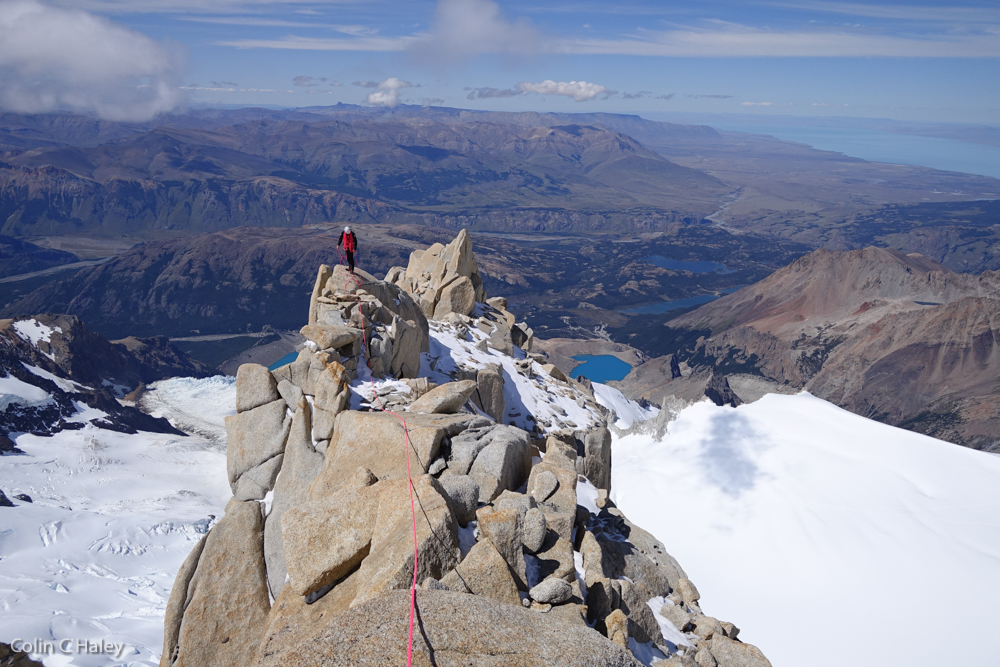












After about a week of mediocre weather, during which we went rock climbing around town, another window of good weather arrived. It was again preceded by lots of precipitation, so at the start of the window conditions were not very good. At first the forecasts made it look like an exceptionally long window of good weather – nearly a week. Wanting to maximize such a long period of good weather, Alex and I planned a long traverse of high summits, starting at Cerro Pollone and heading southward. Accordingly, we packed an enormous quantity of food and fuel, and a very robust supply of pitons, nuts and cord for making innumerable rappels. As the weather window drew nearer, however, the forecast began to deteriorate, and it became clear that it wouldn’t last as long as it appeared to earlier. So, at the last minute, we re-packed, removing some food and fuel. In hindsight, it was lazy on our part to stick with the same plan and simply remove some food and fuel. It would have been wiser to re-evaluate the weather window completely, and come up with a fresh plan. In any case, we hiked into the mountains with enormous packs, and the following day, February 20, headed out climbing with, almost certainly, the heaviest packs I’ve ever brought on a climb anywhere. The weight of our backpacks was somewhat of a point of contention – I had been pleading for us to pack lighter, and Alex had been insisting that a few extra kilos don’t matter. From his perspective, the technical nature of the climbing was easy enough that the weight of the packs wasn’t important. By the end of the weather window, I think he had gained an appreciation for how debilitating heavy packs are, even if the climbing is moderate. To his credit though, he carried the heavier pack much more than I did, as the terrain was the sort on which I am the leader of our rope (climbing in crampons, rather than climbing in rock shoes).
On Feb. 20 we left Piedra Negra at a leisurely hour, and hiked at a relaxed pace, over Paso Cuadrado and up the Fitz Roy Norte glacier. We roped up for the upper portion of the glacier, and then climbed a steep snow slope up to the col between Cerro Pollone and Cerro Piergiorgio, where, finally, we could drop our heavy loads. Liberated from our heavy packs, and after a break to melt snow, we began scampering up the “normal route” on Cerro Pollone. Cerro Pollone’s “normal route” climbs mostly up an ice face, with a short, technical ridge to finish. In 2011 I had attempted to solo this route, and retreated with my hands just a meter below the summit, unable to safely climb the final boulder problem to the summit proper. That attempt was in early-season, snowy conditions, and I figured that Alex and I would easily find a way to climb that final boulder problem, with the late-summer conditions. But, alas, Alex and I arrived below the same summit boulder, and found it similarly unprotectable. We made a short rappel to the north, a tension traverse, a few moves of aid, and arrived on the summit block from the west side. I wouldn’t be surprised if our ascent was only the third-ever complete ascent of Cerro Pollone (the two previous ascents that I know arrived on the true summit were Scott Bennett and Blake Herrington in 2011 (via the W Ridge), and Markus Pucher in 2017 (solo and in winter, via the normal route)). After a pretty quick and straightforward descent, we settled in for our first bivouac at the Pollone-Piergiorgio col.
On Feb. 21 we first climbed to the north summit of Piergiorgio via the Esperando la Cumbre route. There were no really difficult pitches, but a few sections of tricky climbing, and the ice gully that we followed for a few pitches was turning into a waterfall in the sun – we should have woken earlier. Cerro Piergiorgio is a long, serrated fin of a mountain, with many small gendarmes along the summit ridge. From the north summit we began a long journey across this complicated summit ridge, along the way passing the high-points of unfinished routes. We climbed sections of rock, climbed sections of ice, made rappels, and did a lot of traversing across 60-degree ice slopes. When we reached the main summit, it was only the third-ever complete ascent of Cerro Piergiorgio, despite the large amount of traffic and attention the mountain has seen. From the main summit we did more traversing climbing, a number of long, adventurous rappels, and finally a lot more traversing across 60-degree ice slopes, arriving late in the evening to a bivouac in a deep col at the southern end of Piergiorgio’s ridge crest.
At our bivouac the night of Feb. 21 we turned on our inReach and received an updated weather forecast: Winds of 100km were expected by late afternoon the next day. We had been planning to traverse across at least several more summits, but being up high on an exposed ridge crest in winds that strong would certainly be a terrible idea. We went to sleep a bit apprehensive about the following day.
When we woke up on Feb. 22 we received a weather update with the same forecast, which to me meant that we ought to descend off the high, exposed ridgeline before the afternoon. After some more traversing on 60-degree ice slopes, one rappel over a cliff band, and ascending a 60-degree ice gully, we arrived at the col where Cerro Domo Blanco’s normal route passes. We dropped our heavy packs at the col, scampered up to the summit of Domo Blanco, and then began descending Domo Blanco’s normal route into the Marconi valley. After a lot of easy (but exposed and serious) down-climbing on our frontpoints, and a lot of scree and boulder-hopping afterwards, we arrived on the Marconi Glacier, tired and with sore feet. As we began the long hike out to the road from the Marconi Glacier, we were cursing the weather forecast – The weather seemed to be nearly perfect still, and rather than climbing a few more summits, we were hiking out under sunny skies with a bunch of extra food and fuel (plus the rock shoes that we never put on!). All of a sudden, and almost exactly on time, the wind picked up fiercely while we were crossing the Rio Fitz Roy Norte. From there to Piedra del Fraile the gusts were so strong that it was difficult even to hike on flat ground, and we were very glad to not be high up on a mountain. Even though the weather in Patagonia can be extremely bad, it was shown yet again how impressively accurate the weather forecasts in Patagonia often are. We named our traverse (Cerro Pollone – Cerro Piergiorgio – Cerro Domo Blanco) the Crystal Castles Traverse.


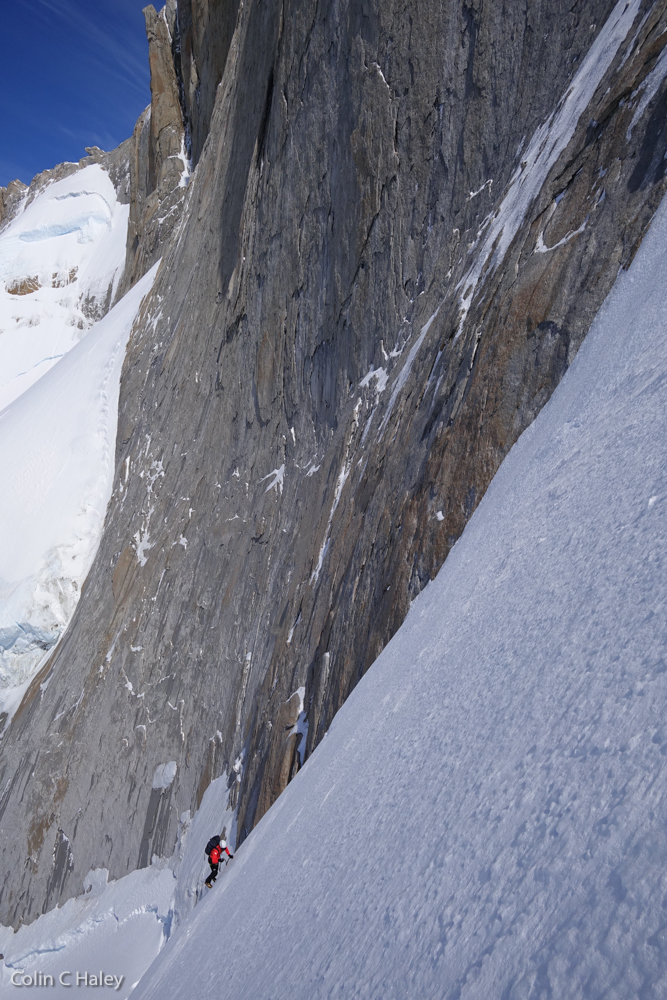

























After a few well-needed restful days in town, Alex and I headed out to the mountains once more, just for a day trip on Feb. 27. The forecast did not look very promising, but Alex had a flight home the next day, and we had gear to collect from Piedra Negra anyways, so there was no harm in trying. We hiked in with the assumption that it might be too windy to climb, and that we might simply retrieve our gear and hike back out. However, when we arrived to Piedra Negra the wind seemed to be rapidly dissipating, so after a bit of reorganization we continued up, towards Cerro Electrico Oeste. Cerro Electrico Oeste is a small, craggy peak of metamorphic rock, to the north of Paso del Cuadrado. It is not spectacular or big by Chaltén standards, but nonetheless a cool peak, and one that is quite prominent and aesthetic when viewed from Piedra Negra. We were soon scrambling up a buttress on the northeast side of the peak, and shortly afterwards I stopped on a ledge to switch to rock shoes (Alex stayed in approach shoes).
Over a few hours we made what is almost certainly the first ascent of Cerro Electrico Oeste. We stayed on the ridgeline the entire way, scrambling over many smaller gendarmes. Although we had a rope and rack, the climbing was just barely easy enough to keep simul-soloing. The loose nature of the rock would’ve anyways made it difficult to protect well. A short ways south of the main summit is a very slender gendarme that was the most spectacular summit along the traverse, and on the descent from this gendarme we used the rope to make one 30m rappel.
The sharp, exposed ridge crest became more gentle shortly before Paso del Cuadrado, where the rock changed from red, metamorphic rock to good granite. Having been climbing for a few hours on “high alert,” on the loose, metamorphic rock, it felt very casual and nonchalant to climb again on trustworthy granite. From Paso del Cuadrado we continued south towards Aguja Guillaumet, passing the first two towers on the west side of the ridge, passing directly over the next two towers, and eventually joining the Giordani route on Aguja Guillaumet. We kept simul-soloing up the Giordani route, and finally roped up at the base of the Comesaña-Fonrouge. Although it is a classic of the range, the Comesaña-Fonrouge felt like an afterthought after all the climbing we’d already done, and we simul-climbed it in two pitches, arriving quickly on the summit of Aguja Guillaumet. After a fiasco on the descent with a Beal Escaper (I still think these devices hold some promise, but I now view them with a lot of suspicion), we eventually rappelled over the bergschrund of the Amy Route, and began the long, nocturnal hike out of the mountains. We arrived in Chaltén late at night, and after a few hours of sleep Alex caught his bus to the airport.









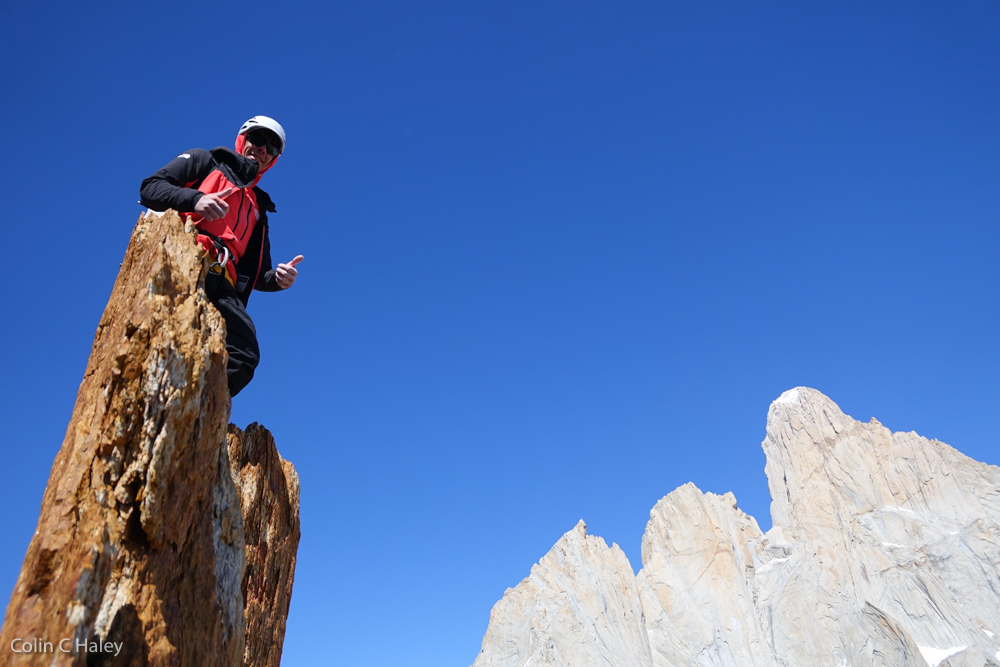




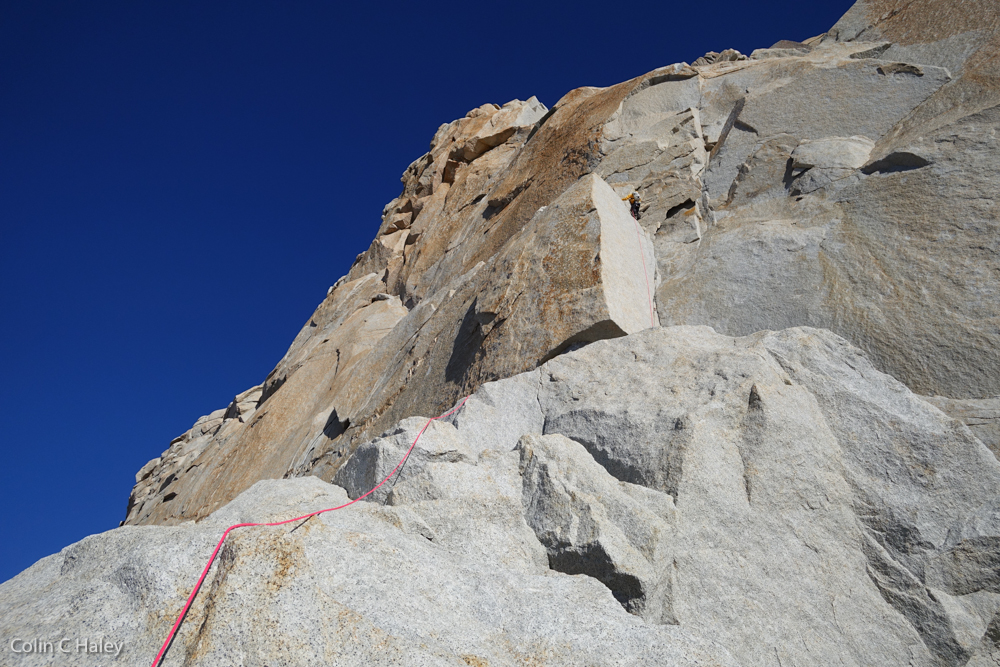

REFLECTIONS
In January the weather was so poor that unfortunately Fabi and I never had a real chance to see what we could climb together. In February Alex and I got in some good climbing, covering cool terrain. The climbing Alex and I managed to do was noteworthy, and made the trip to Patagonia worthwhile, but was nothing major – certainly nothing in comparison to the climbing we did together in Patagonia in 2016. That discrepancy is mostly because we benefited from such amazingly good weather and conditions in 2016, and I think that we were both climbing well this year. However, in Patagonia a big part of success comes from picking the right objective for the given circumstances of weather and conditions. This year I think we could have pulled off some better climbing if we had been a bit more cunning with our choices of objectives. Overall, I consider my 2019-2020 Chaltén season to be moderately successful. I’ve had less fruitful seasons, and also much more fruitful seasons.
For me personally, perhaps the most notable thing about my 2019-2020 Chaltén climbing season is the realization is that it will be perhaps my last. I won’t be surprised if I return to Chaltén in the future, but I think it would more likely be for shorter trips to pursue one specific objective, rather than a multi-month quest to climb as much as possible. For an entire decade of my life, climbing in the Chaltén Massif was the main focus of my ambition, and it was an extremely important, rewarding chapter of my life. I feel now that it’s time to shift my attention more to other mountain ranges.
Although I enjoy rock climbing a lot, I’ve always felt most inspired by alpine climbing. Climbing in an extreme, high-alpine environment is a journey into another world, distinct from the world we inhabit in normal life. My first trips to the Chaltén Massif always felt like extreme alpine climbing, and for the most part, the Torres still are extreme alpine climbing. But, over time, climbing in the Chaltén Massif has felt less and less like a journey into another world. Partly this is due to actual changes in the climate. The peaks have literally become drier and warmer, snow has melted out from the approach gullies, and the glaciers are disappearing incredibly fast. There are now many peaks in the Chaltén Massif that are commonly climbed with just approach shoes and rock shoes. In my personal opinion, if you don’t need crampons, it’s not alpine climbing anymore. I’ve always found it funny in the contiguous US how things like The Incredible Hulk or Prusik Peak are referred to as “alpine rock climbing.” Most “alpine rock climbing” in the contiguous US is just normal rock climbing with a long approach! Of course not needing crampons doesn’t mean that a climb isn’t cool, or isn’t challenging, but for me personally I don’t feel the same level of inspiration that I do for full-on alpine climbing in an extreme environment. In addition to the changing climate, the feeling of climbing in the Chaltén Massif has also changed because of all the traffic. The approach trails are now packed with trekking tourists, the easy routes are often packed with climbers, there is a wealth of information about the climbing routes, there are good weather forecasts, and the proliferation of rappel anchors all over the peaks has made them feel less serious and committing.
However, the previous paragraph is not meant to be dismissive of the Chaltén Massif. I think it is literally the most beautiful, spectacular topography on Earth, and generations of climbers will continue to find immense challenge and inspiration there. My feeling that it’s time to move on has mostly to do with my own history and evolving ambitions. The Chaltén Massif has been the stage for a huge portion of my climbing career, and as a result it has slowly become less exciting to me, simply due to familiarity. For the 10-year period of 2007-2016 I think I accomplished more in this mountain range than anyone else, and by a significant margin. I might be criticized as arrogant for saying so, but it’s my genuine opinion. I’m very proud of my accomplishments in the Chaltén Massif, and I have never respected false modesty. In my opinion it is best to be honest and realistic, rather than falsely modest or unjustifiably proud. It is impossible to summarize my Chaltén saga in a few paragraphs, and perhaps someday I’ll write about in in depth, but for the moment I’ll just state a few summit statistics:
—I’ve made 17 total trips to Chaltén, and in total have spent more than 3 years of my life there. In those 17 trips I only ever once drove further east than the ranger station (a day trip to get my delayed luggage from El Calafate).
—I have made the first complete ascent of 6-9 summits in the Chaltén Massif (Cerro Electrico NE, Aguja Volonqui, Cerro Marconi Central, Cerro Piergiorgio, Torrissimo, Cerro Huemul (not certain), both summits of Filo del Hombre Sentado (not certain), and Cerro Electrico Oeste).
—I have made solo ascents of 23 summits in the Chaltén Massif (Cerro Electrico NE, Cerro Electrico Main, Techado Negro, Aguja Guillaumet, Aguja Mermoz, Chaltén, Aguja Poincenot, Aguja Rafael, Aguja St. Exupery, Aguja de l’S, Cerro Domo Blanco, Aguja Standhardt, Punta Herron, Torre Egger, Adela Norte, Adela Central, Adela Sur, Cerro El Ñato, Cerro Doblado, Cerro Grande, Cerro Solo, and both summits of Filo del Hombre Sentado).
—I have climbed Chaltén (AKA Fitz Roy) 12 times, including 2 ascents solo.
—I have climbed Cerro Torre 8 times, by a variety of first link-ups, first traverses, new variations, etc.
—I have climbed Torre Egger 7 times, including the first solo ascent.
—I have climbed Punta Herron 6 times, including the first solo ascent.
—I have climbed Aguja Standhardt 9 times, including the first solo ascent.
These statistics show only a fraction of my climbing achievements in the Chaltén Massif, and show only the successes, not any of the many, many times I’ve bailed off of objectives. In short, I’ve done a ton of climbing in the Chaltén Massif.
My first trip to Chaltén was in Dec. 2003, when I was nineteen years old, with my friend Bart Paull. Our biggest accomplishment was climbing Aguja Poincenot by the Whillans route. It is a route that I consider very easy now, but at the time it absolutely blew my mind. I vividly remember hiking out at the end of the trip (we stayed in Rio Blanco basecamp, before the town of El Chaltén had much going on), and staring up at Aguja Poincenot, amazed that we had managed to climb such a spectacular mountain. On that trip I gazed awestruck at Chaltén and Cerro Torre, knowing that I wasn’t good enough to climb them, and dreaming of someday being able to do so. My first time climbing Chaltén, in 2005 with Mark Westman, is such a vivid memory of such an exciting climb because both of us were breaking through barriers in our progressions as climbers. By contrast, my most recent ascent of Chaltén was in 2018 with Austin Siadak. We climbed the Afanassieff Route, the longest on the mountain, in fewer than 11 hours despite bad conditions. It was a super fast ascent of a long route on a spectacular mountain… but I hardly felt a fraction of the excitement and wonder that I had climbing Chaltén my first time. Even though my exploits on these peaks have become much more impressive as my climbing abilities have improved, the mystique of these mountains has inevitably declined for me.
In his 1963 article, “Modern Yosemite Climbing,” Yvon Chouinard famously and accurately predicted that the bigwall techniques emerging in Yosemite at the time would lead to a wave of ascents of steep walls on “the high mountains of the world.” Chouinard said that Yosemite was “the training ground for a new generation of superalpinists.” He was proven to be largely correct, and the Chaltén Massif is one of the major destinations where Yosemite-trained climbers, such as himself, left their mark. While my decade-and-a-half of climbing in the Chaltén Massif has certainly left me with a wealth of memories, I think it has also greatly improved me as an alpinist. My ambitions in the Chaltén Massif were the driving motivation to improve my rock climbing abilities during the last chapter of my life, going from a 5.11a sport climber at the time of my first Poincenot ascent, to a 5.13c sport climber today. When I first started climbing in Chaltén I was already an efficient alpinist on classic alpine terrain, but climbing in the Chaltén Massif has taught me how to be fast and efficient on much harder, steeper terrain. Perhaps the Chaltén Massif has been the training ground for me that Yosemite Valley was for Chouinard, and if I’m lucky, hopefully the skills I’ve developed in the Chaltén Massif will prove useful for me on bigger mountains elsewhere. My desire now is to find the mountains that give me the same feeling I had on my first trips to Chaltén – that to make it to that spectacular summit, no matter by what route, would be an amazing accomplishment – the most natural, and least-contrived climbing experience.

